Australian Taxation Law and Policy
VerifiedAdded on 2020/04/07
|14
|2837
|38
AI Summary
This assignment delves into the intricate world of Australian taxation law and policy. It examines various aspects, including the legal framework governing taxation, key policies implemented in Australia, and the impact of these policies on both individuals and businesses. The analysis considers diverse perspectives on taxation, including its role in revenue generation, social welfare, and economic development.
Contribute Materials
Your contribution can guide someone’s learning journey. Share your
documents today.
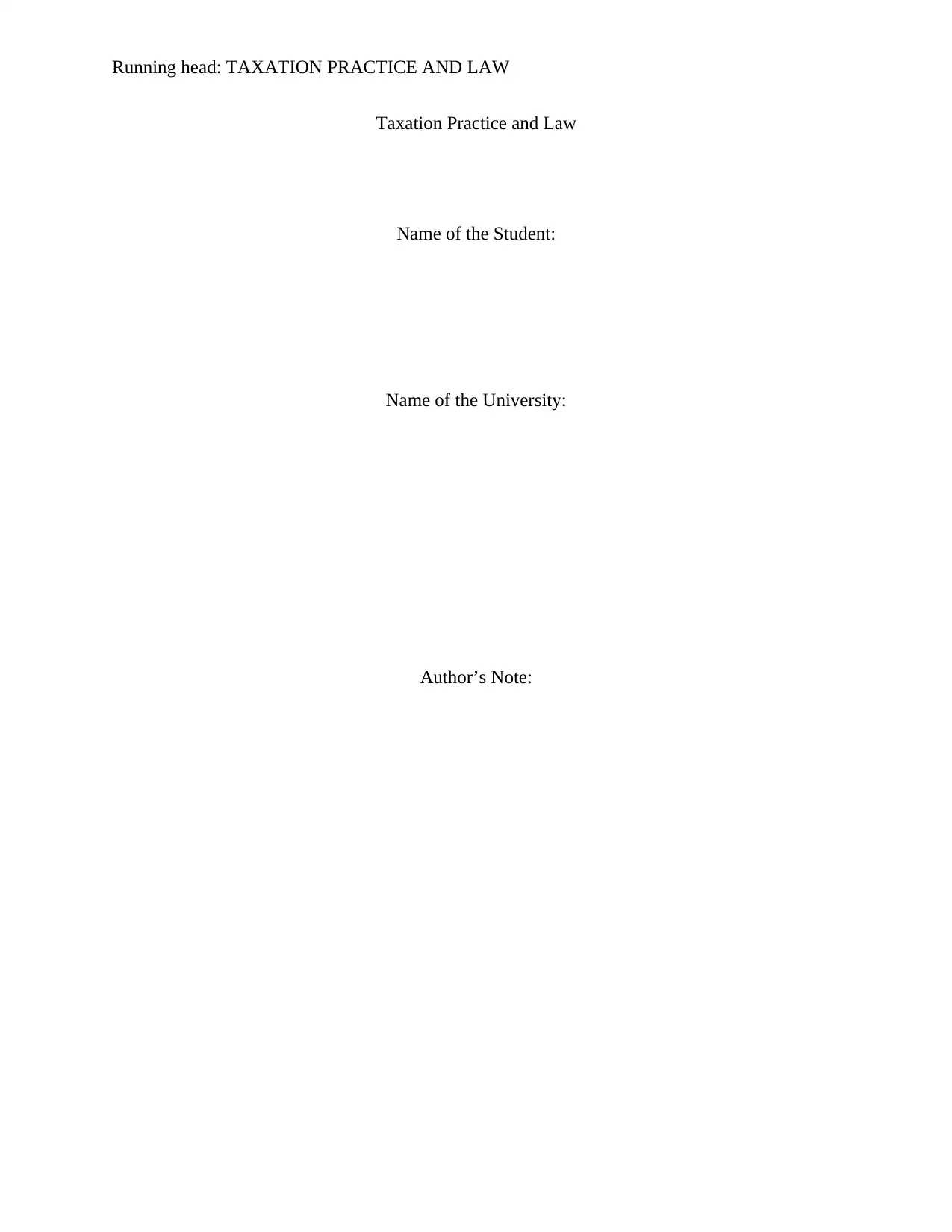
Running head: TAXATION PRACTICE AND LAW
Taxation Practice and Law
Name of the Student:
Name of the University:
Author’s Note:
Taxation Practice and Law
Name of the Student:
Name of the University:
Author’s Note:
Secure Best Marks with AI Grader
Need help grading? Try our AI Grader for instant feedback on your assignments.
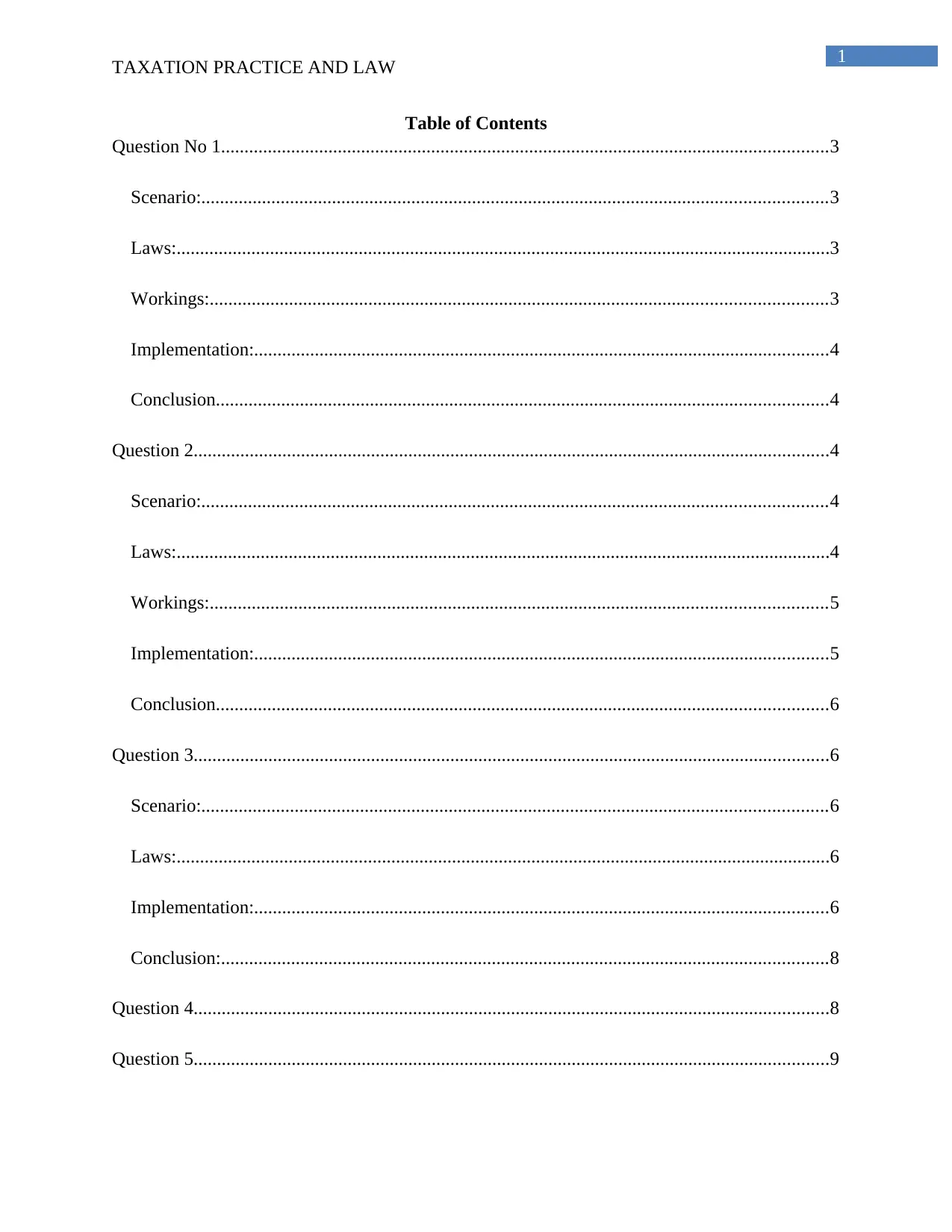
1
TAXATION PRACTICE AND LAW
Table of Contents
Question No 1..................................................................................................................................3
Scenario:......................................................................................................................................3
Laws:............................................................................................................................................3
Workings:....................................................................................................................................3
Implementation:...........................................................................................................................4
Conclusion...................................................................................................................................4
Question 2........................................................................................................................................4
Scenario:......................................................................................................................................4
Laws:............................................................................................................................................4
Workings:....................................................................................................................................5
Implementation:...........................................................................................................................5
Conclusion...................................................................................................................................6
Question 3........................................................................................................................................6
Scenario:......................................................................................................................................6
Laws:............................................................................................................................................6
Implementation:...........................................................................................................................6
Conclusion:..................................................................................................................................8
Question 4........................................................................................................................................8
Question 5........................................................................................................................................9
TAXATION PRACTICE AND LAW
Table of Contents
Question No 1..................................................................................................................................3
Scenario:......................................................................................................................................3
Laws:............................................................................................................................................3
Workings:....................................................................................................................................3
Implementation:...........................................................................................................................4
Conclusion...................................................................................................................................4
Question 2........................................................................................................................................4
Scenario:......................................................................................................................................4
Laws:............................................................................................................................................4
Workings:....................................................................................................................................5
Implementation:...........................................................................................................................5
Conclusion...................................................................................................................................6
Question 3........................................................................................................................................6
Scenario:......................................................................................................................................6
Laws:............................................................................................................................................6
Implementation:...........................................................................................................................6
Conclusion:..................................................................................................................................8
Question 4........................................................................................................................................8
Question 5........................................................................................................................................9
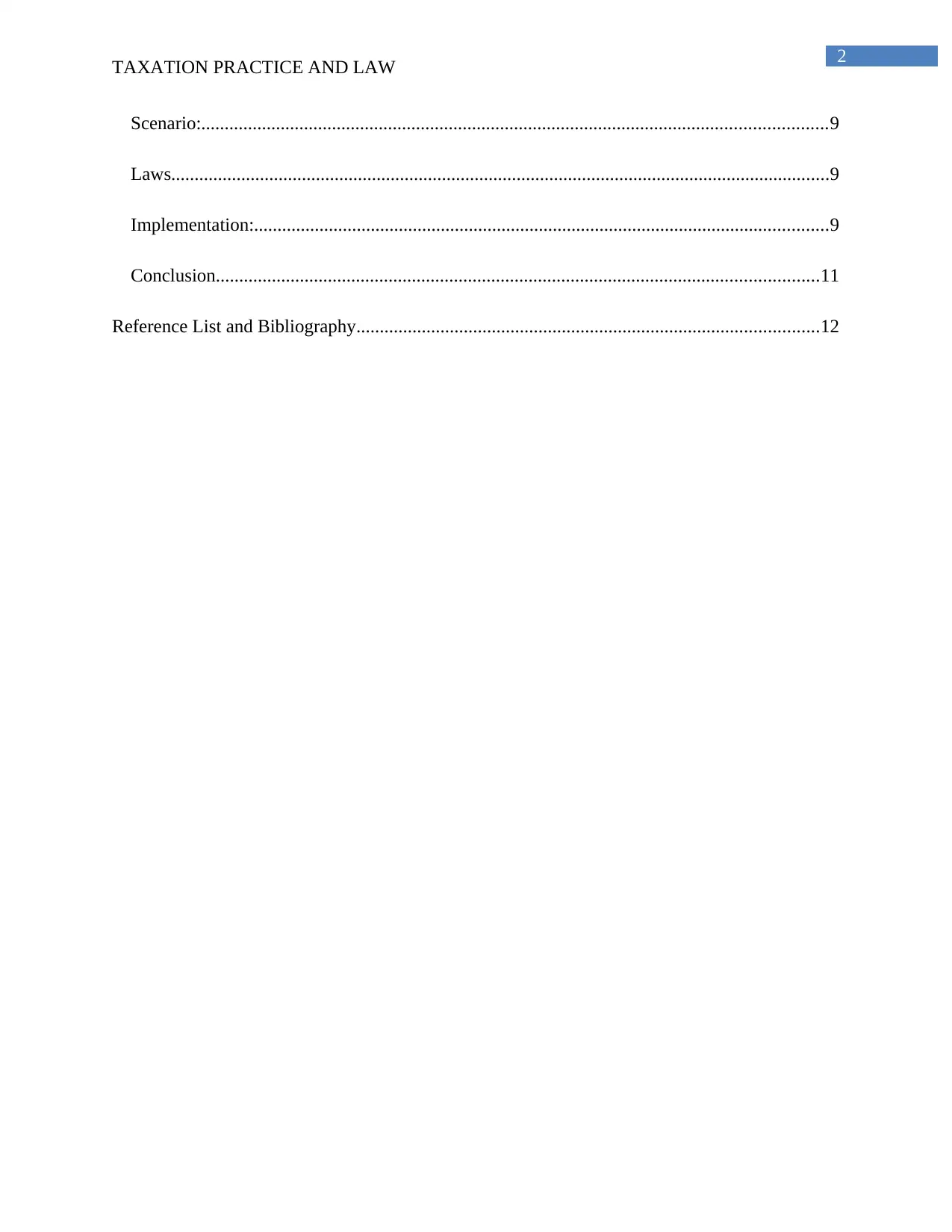
2
TAXATION PRACTICE AND LAW
Scenario:......................................................................................................................................9
Laws.............................................................................................................................................9
Implementation:...........................................................................................................................9
Conclusion.................................................................................................................................11
Reference List and Bibliography...................................................................................................12
TAXATION PRACTICE AND LAW
Scenario:......................................................................................................................................9
Laws.............................................................................................................................................9
Implementation:...........................................................................................................................9
Conclusion.................................................................................................................................11
Reference List and Bibliography...................................................................................................12
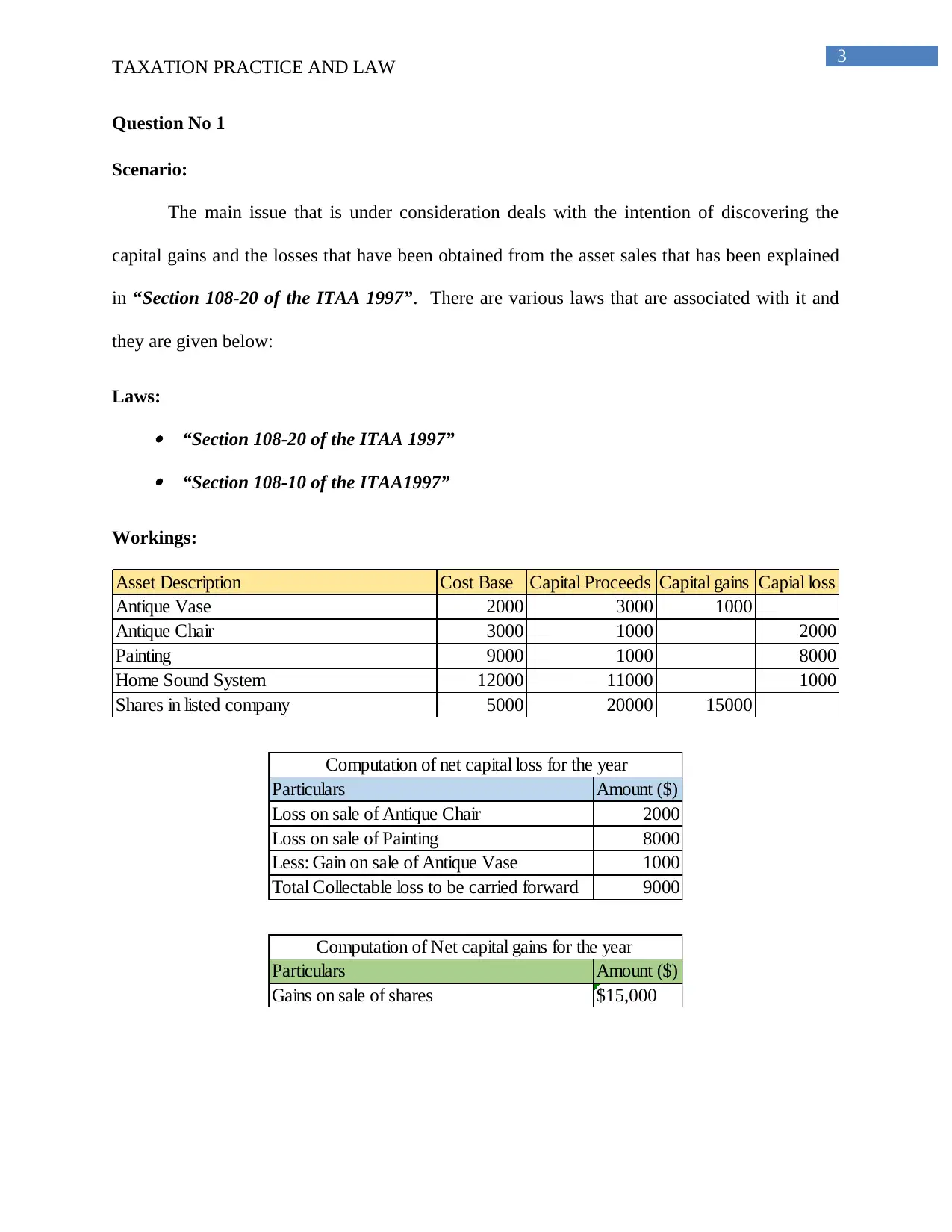
3
TAXATION PRACTICE AND LAW
Question No 1
Scenario:
The main issue that is under consideration deals with the intention of discovering the
capital gains and the losses that have been obtained from the asset sales that has been explained
in “Section 108-20 of the ITAA 1997”. There are various laws that are associated with it and
they are given below:
Laws: “Section 108-20 of the ITAA 1997” “Section 108-10 of the ITAA1997”
Workings:
Asset Description Cost Base Capital Proceeds Capital gains Capial loss
Antique Vase 2000 3000 1000
Antique Chair 3000 1000 2000
Painting 9000 1000 8000
Home Sound System 12000 11000 1000
Shares in listed company 5000 20000 15000
Particulars Amount ($)
Loss on sale of Antique Chair 2000
Loss on sale of Painting 8000
Less: Gain on sale of Antique Vase 1000
Total Collectable loss to be carried forward 9000
Computation of net capital loss for the year
Particulars Amount ($)
Gains on sale of shares $15,000
Computation of Net capital gains for the year
TAXATION PRACTICE AND LAW
Question No 1
Scenario:
The main issue that is under consideration deals with the intention of discovering the
capital gains and the losses that have been obtained from the asset sales that has been explained
in “Section 108-20 of the ITAA 1997”. There are various laws that are associated with it and
they are given below:
Laws: “Section 108-20 of the ITAA 1997” “Section 108-10 of the ITAA1997”
Workings:
Asset Description Cost Base Capital Proceeds Capital gains Capial loss
Antique Vase 2000 3000 1000
Antique Chair 3000 1000 2000
Painting 9000 1000 8000
Home Sound System 12000 11000 1000
Shares in listed company 5000 20000 15000
Particulars Amount ($)
Loss on sale of Antique Chair 2000
Loss on sale of Painting 8000
Less: Gain on sale of Antique Vase 1000
Total Collectable loss to be carried forward 9000
Computation of net capital loss for the year
Particulars Amount ($)
Gains on sale of shares $15,000
Computation of Net capital gains for the year
Secure Best Marks with AI Grader
Need help grading? Try our AI Grader for instant feedback on your assignments.
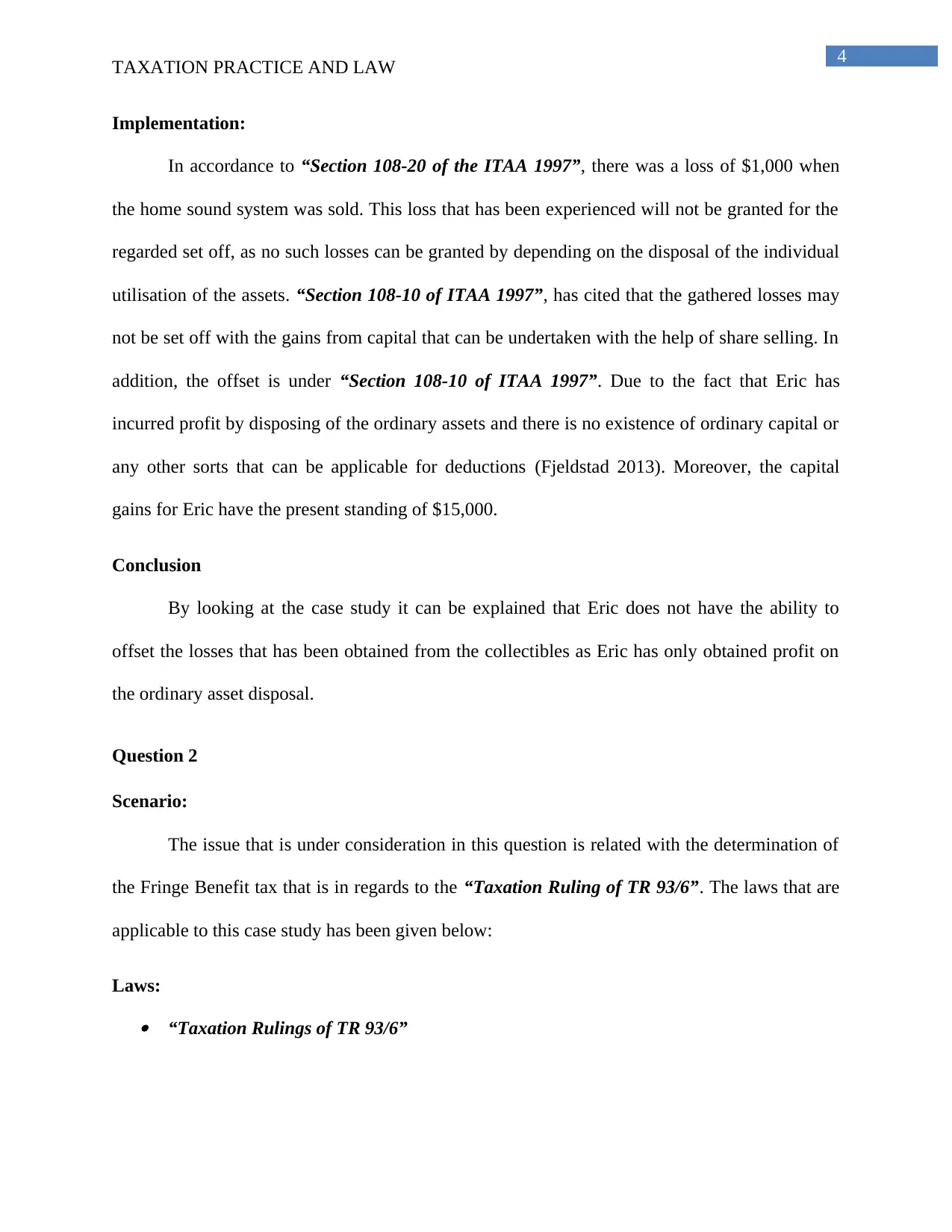
4
TAXATION PRACTICE AND LAW
Implementation:
In accordance to “Section 108-20 of the ITAA 1997”, there was a loss of $1,000 when
the home sound system was sold. This loss that has been experienced will not be granted for the
regarded set off, as no such losses can be granted by depending on the disposal of the individual
utilisation of the assets. “Section 108-10 of ITAA 1997”, has cited that the gathered losses may
not be set off with the gains from capital that can be undertaken with the help of share selling. In
addition, the offset is under “Section 108-10 of ITAA 1997”. Due to the fact that Eric has
incurred profit by disposing of the ordinary assets and there is no existence of ordinary capital or
any other sorts that can be applicable for deductions (Fjeldstad 2013). Moreover, the capital
gains for Eric have the present standing of $15,000.
Conclusion
By looking at the case study it can be explained that Eric does not have the ability to
offset the losses that has been obtained from the collectibles as Eric has only obtained profit on
the ordinary asset disposal.
Question 2
Scenario:
The issue that is under consideration in this question is related with the determination of
the Fringe Benefit tax that is in regards to the “Taxation Ruling of TR 93/6”. The laws that are
applicable to this case study has been given below:
Laws: “Taxation Rulings of TR 93/6”
TAXATION PRACTICE AND LAW
Implementation:
In accordance to “Section 108-20 of the ITAA 1997”, there was a loss of $1,000 when
the home sound system was sold. This loss that has been experienced will not be granted for the
regarded set off, as no such losses can be granted by depending on the disposal of the individual
utilisation of the assets. “Section 108-10 of ITAA 1997”, has cited that the gathered losses may
not be set off with the gains from capital that can be undertaken with the help of share selling. In
addition, the offset is under “Section 108-10 of ITAA 1997”. Due to the fact that Eric has
incurred profit by disposing of the ordinary assets and there is no existence of ordinary capital or
any other sorts that can be applicable for deductions (Fjeldstad 2013). Moreover, the capital
gains for Eric have the present standing of $15,000.
Conclusion
By looking at the case study it can be explained that Eric does not have the ability to
offset the losses that has been obtained from the collectibles as Eric has only obtained profit on
the ordinary asset disposal.
Question 2
Scenario:
The issue that is under consideration in this question is related with the determination of
the Fringe Benefit tax that is in regards to the “Taxation Ruling of TR 93/6”. The laws that are
applicable to this case study has been given below:
Laws: “Taxation Rulings of TR 93/6”
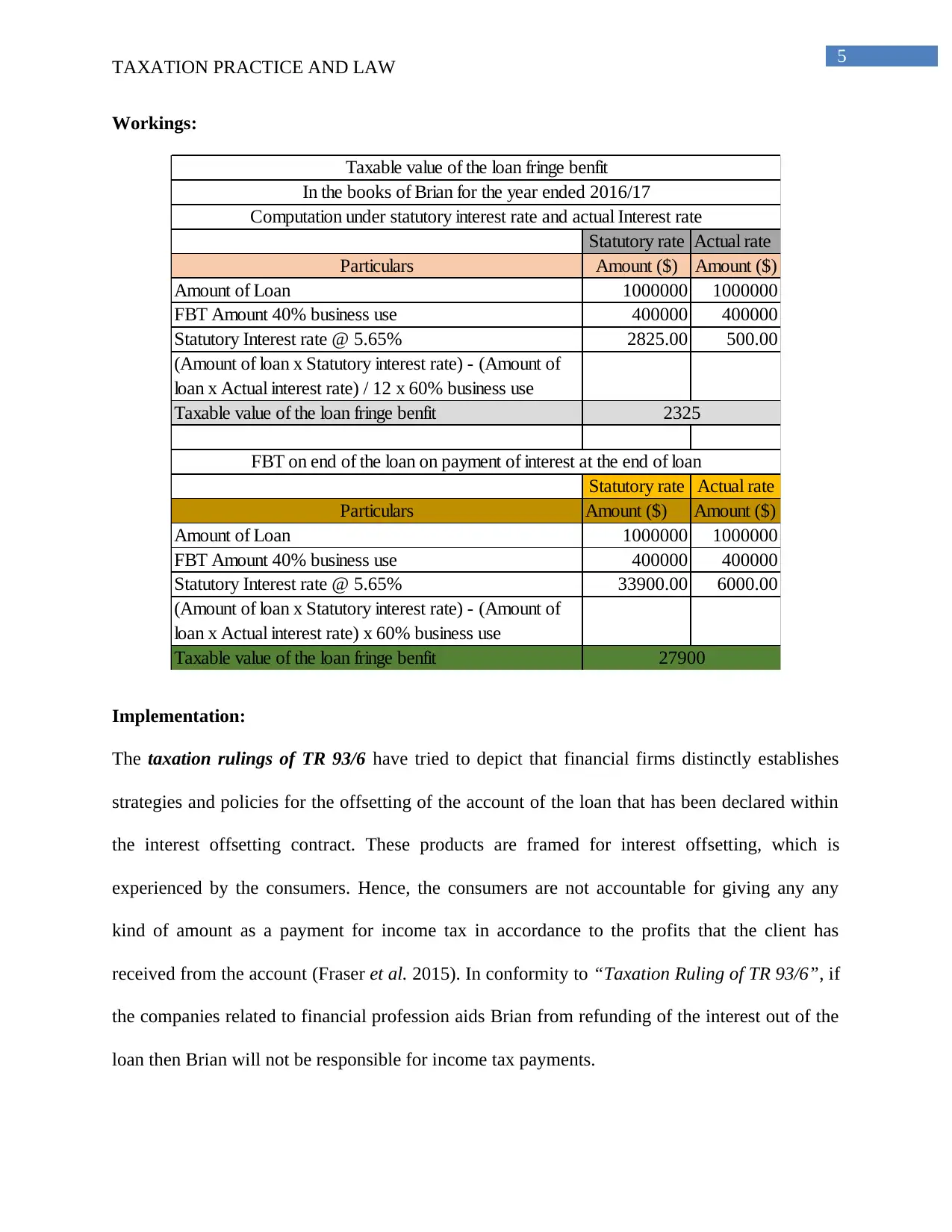
5
TAXATION PRACTICE AND LAW
Workings:
Statutory rate Actual rate
Particulars Amount ($) Amount ($)
Amount of Loan 1000000 1000000
FBT Amount 40% business use 400000 400000
Statutory Interest rate @ 5.65% 2825.00 500.00
(Amount of loan x Statutory interest rate) - (Amount of
loan x Actual interest rate) / 12 x 60% business use
Taxable value of the loan fringe benfit
Statutory rate Actual rate
Particulars Amount ($) Amount ($)
Amount of Loan 1000000 1000000
FBT Amount 40% business use 400000 400000
Statutory Interest rate @ 5.65% 33900.00 6000.00
(Amount of loan x Statutory interest rate) - (Amount of
loan x Actual interest rate) x 60% business use
Taxable value of the loan fringe benfit
2325
27900
FBT on end of the loan on payment of interest at the end of loan
Taxable value of the loan fringe benfit
In the books of Brian for the year ended 2016/17
Computation under statutory interest rate and actual Interest rate
Implementation:
The taxation rulings of TR 93/6 have tried to depict that financial firms distinctly establishes
strategies and policies for the offsetting of the account of the loan that has been declared within
the interest offsetting contract. These products are framed for interest offsetting, which is
experienced by the consumers. Hence, the consumers are not accountable for giving any any
kind of amount as a payment for income tax in accordance to the profits that the client has
received from the account (Fraser et al. 2015). In conformity to “Taxation Ruling of TR 93/6”, if
the companies related to financial profession aids Brian from refunding of the interest out of the
loan then Brian will not be responsible for income tax payments.
TAXATION PRACTICE AND LAW
Workings:
Statutory rate Actual rate
Particulars Amount ($) Amount ($)
Amount of Loan 1000000 1000000
FBT Amount 40% business use 400000 400000
Statutory Interest rate @ 5.65% 2825.00 500.00
(Amount of loan x Statutory interest rate) - (Amount of
loan x Actual interest rate) / 12 x 60% business use
Taxable value of the loan fringe benfit
Statutory rate Actual rate
Particulars Amount ($) Amount ($)
Amount of Loan 1000000 1000000
FBT Amount 40% business use 400000 400000
Statutory Interest rate @ 5.65% 33900.00 6000.00
(Amount of loan x Statutory interest rate) - (Amount of
loan x Actual interest rate) x 60% business use
Taxable value of the loan fringe benfit
2325
27900
FBT on end of the loan on payment of interest at the end of loan
Taxable value of the loan fringe benfit
In the books of Brian for the year ended 2016/17
Computation under statutory interest rate and actual Interest rate
Implementation:
The taxation rulings of TR 93/6 have tried to depict that financial firms distinctly establishes
strategies and policies for the offsetting of the account of the loan that has been declared within
the interest offsetting contract. These products are framed for interest offsetting, which is
experienced by the consumers. Hence, the consumers are not accountable for giving any any
kind of amount as a payment for income tax in accordance to the profits that the client has
received from the account (Fraser et al. 2015). In conformity to “Taxation Ruling of TR 93/6”, if
the companies related to financial profession aids Brian from refunding of the interest out of the
loan then Brian will not be responsible for income tax payments.
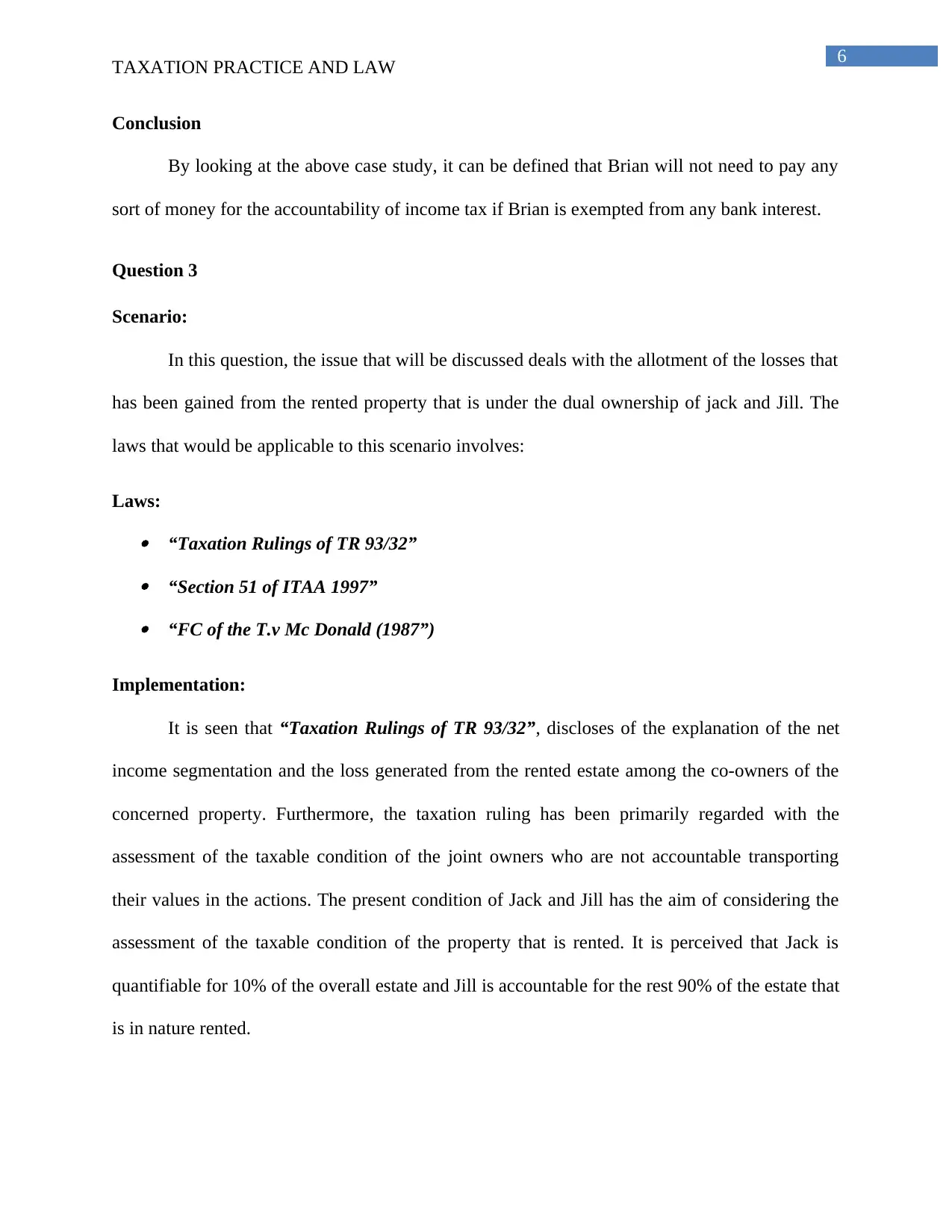
6
TAXATION PRACTICE AND LAW
Conclusion
By looking at the above case study, it can be defined that Brian will not need to pay any
sort of money for the accountability of income tax if Brian is exempted from any bank interest.
Question 3
Scenario:
In this question, the issue that will be discussed deals with the allotment of the losses that
has been gained from the rented property that is under the dual ownership of jack and Jill. The
laws that would be applicable to this scenario involves:
Laws: “Taxation Rulings of TR 93/32” “Section 51 of ITAA 1997” “FC of the T.v Mc Donald (1987”)
Implementation:
It is seen that “Taxation Rulings of TR 93/32”, discloses of the explanation of the net
income segmentation and the loss generated from the rented estate among the co-owners of the
concerned property. Furthermore, the taxation ruling has been primarily regarded with the
assessment of the taxable condition of the joint owners who are not accountable transporting
their values in the actions. The present condition of Jack and Jill has the aim of considering the
assessment of the taxable condition of the property that is rented. It is perceived that Jack is
quantifiable for 10% of the overall estate and Jill is accountable for the rest 90% of the estate that
is in nature rented.
TAXATION PRACTICE AND LAW
Conclusion
By looking at the above case study, it can be defined that Brian will not need to pay any
sort of money for the accountability of income tax if Brian is exempted from any bank interest.
Question 3
Scenario:
In this question, the issue that will be discussed deals with the allotment of the losses that
has been gained from the rented property that is under the dual ownership of jack and Jill. The
laws that would be applicable to this scenario involves:
Laws: “Taxation Rulings of TR 93/32” “Section 51 of ITAA 1997” “FC of the T.v Mc Donald (1987”)
Implementation:
It is seen that “Taxation Rulings of TR 93/32”, discloses of the explanation of the net
income segmentation and the loss generated from the rented estate among the co-owners of the
concerned property. Furthermore, the taxation ruling has been primarily regarded with the
assessment of the taxable condition of the joint owners who are not accountable transporting
their values in the actions. The present condition of Jack and Jill has the aim of considering the
assessment of the taxable condition of the property that is rented. It is perceived that Jack is
quantifiable for 10% of the overall estate and Jill is accountable for the rest 90% of the estate that
is in nature rented.
Paraphrase This Document
Need a fresh take? Get an instant paraphrase of this document with our AI Paraphraser
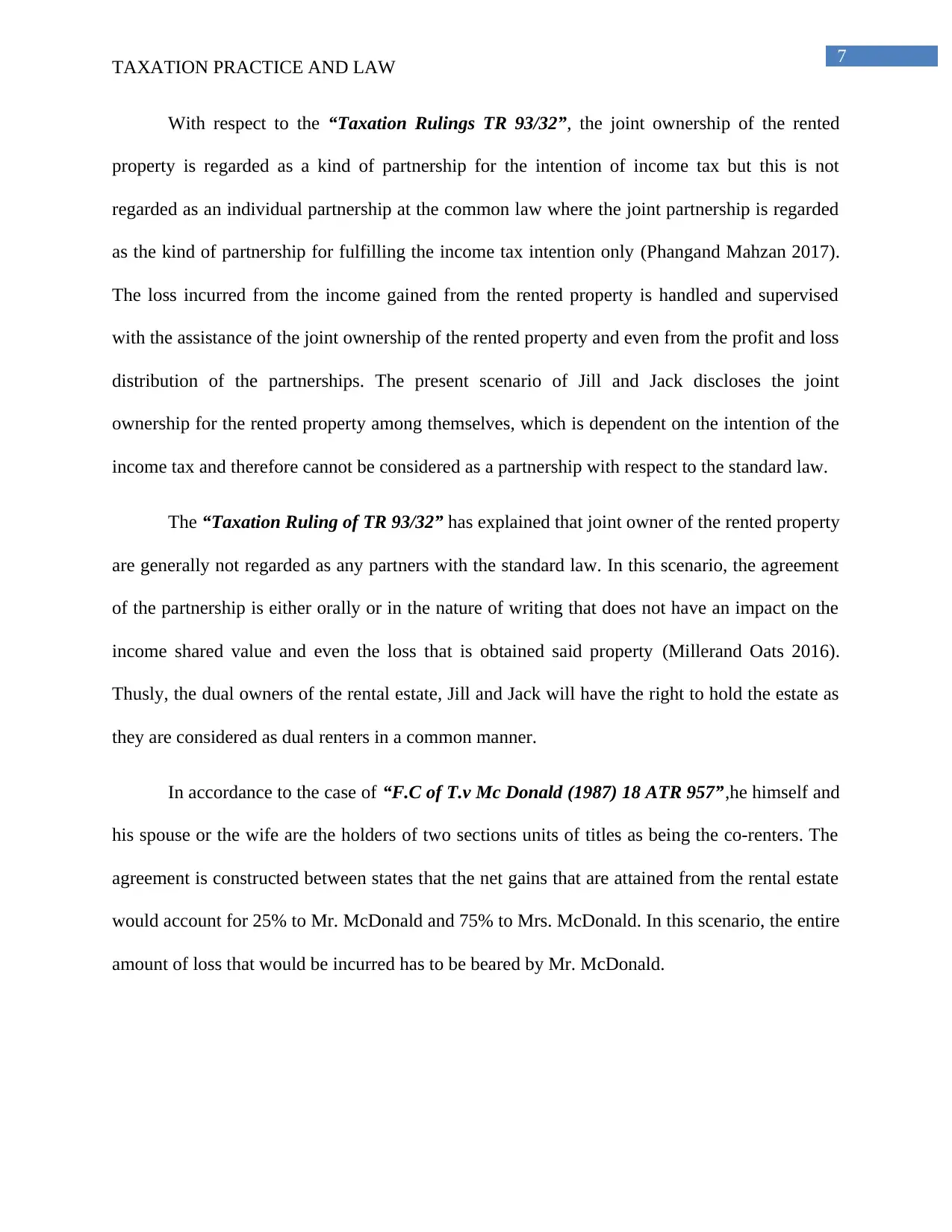
7
TAXATION PRACTICE AND LAW
With respect to the “Taxation Rulings TR 93/32”, the joint ownership of the rented
property is regarded as a kind of partnership for the intention of income tax but this is not
regarded as an individual partnership at the common law where the joint partnership is regarded
as the kind of partnership for fulfilling the income tax intention only (Phangand Mahzan 2017).
The loss incurred from the income gained from the rented property is handled and supervised
with the assistance of the joint ownership of the rented property and even from the profit and loss
distribution of the partnerships. The present scenario of Jill and Jack discloses the joint
ownership for the rented property among themselves, which is dependent on the intention of the
income tax and therefore cannot be considered as a partnership with respect to the standard law.
The “Taxation Ruling of TR 93/32” has explained that joint owner of the rented property
are generally not regarded as any partners with the standard law. In this scenario, the agreement
of the partnership is either orally or in the nature of writing that does not have an impact on the
income shared value and even the loss that is obtained said property (Millerand Oats 2016).
Thusly, the dual owners of the rental estate, Jill and Jack will have the right to hold the estate as
they are considered as dual renters in a common manner.
In accordance to the case of “F.C of T.v Mc Donald (1987) 18 ATR 957”,he himself and
his spouse or the wife are the holders of two sections units of titles as being the co-renters. The
agreement is constructed between states that the net gains that are attained from the rental estate
would account for 25% to Mr. McDonald and 75% to Mrs. McDonald. In this scenario, the entire
amount of loss that would be incurred has to be beared by Mr. McDonald.
TAXATION PRACTICE AND LAW
With respect to the “Taxation Rulings TR 93/32”, the joint ownership of the rented
property is regarded as a kind of partnership for the intention of income tax but this is not
regarded as an individual partnership at the common law where the joint partnership is regarded
as the kind of partnership for fulfilling the income tax intention only (Phangand Mahzan 2017).
The loss incurred from the income gained from the rented property is handled and supervised
with the assistance of the joint ownership of the rented property and even from the profit and loss
distribution of the partnerships. The present scenario of Jill and Jack discloses the joint
ownership for the rented property among themselves, which is dependent on the intention of the
income tax and therefore cannot be considered as a partnership with respect to the standard law.
The “Taxation Ruling of TR 93/32” has explained that joint owner of the rented property
are generally not regarded as any partners with the standard law. In this scenario, the agreement
of the partnership is either orally or in the nature of writing that does not have an impact on the
income shared value and even the loss that is obtained said property (Millerand Oats 2016).
Thusly, the dual owners of the rental estate, Jill and Jack will have the right to hold the estate as
they are considered as dual renters in a common manner.
In accordance to the case of “F.C of T.v Mc Donald (1987) 18 ATR 957”,he himself and
his spouse or the wife are the holders of two sections units of titles as being the co-renters. The
agreement is constructed between states that the net gains that are attained from the rental estate
would account for 25% to Mr. McDonald and 75% to Mrs. McDonald. In this scenario, the entire
amount of loss that would be incurred has to be beared by Mr. McDonald.
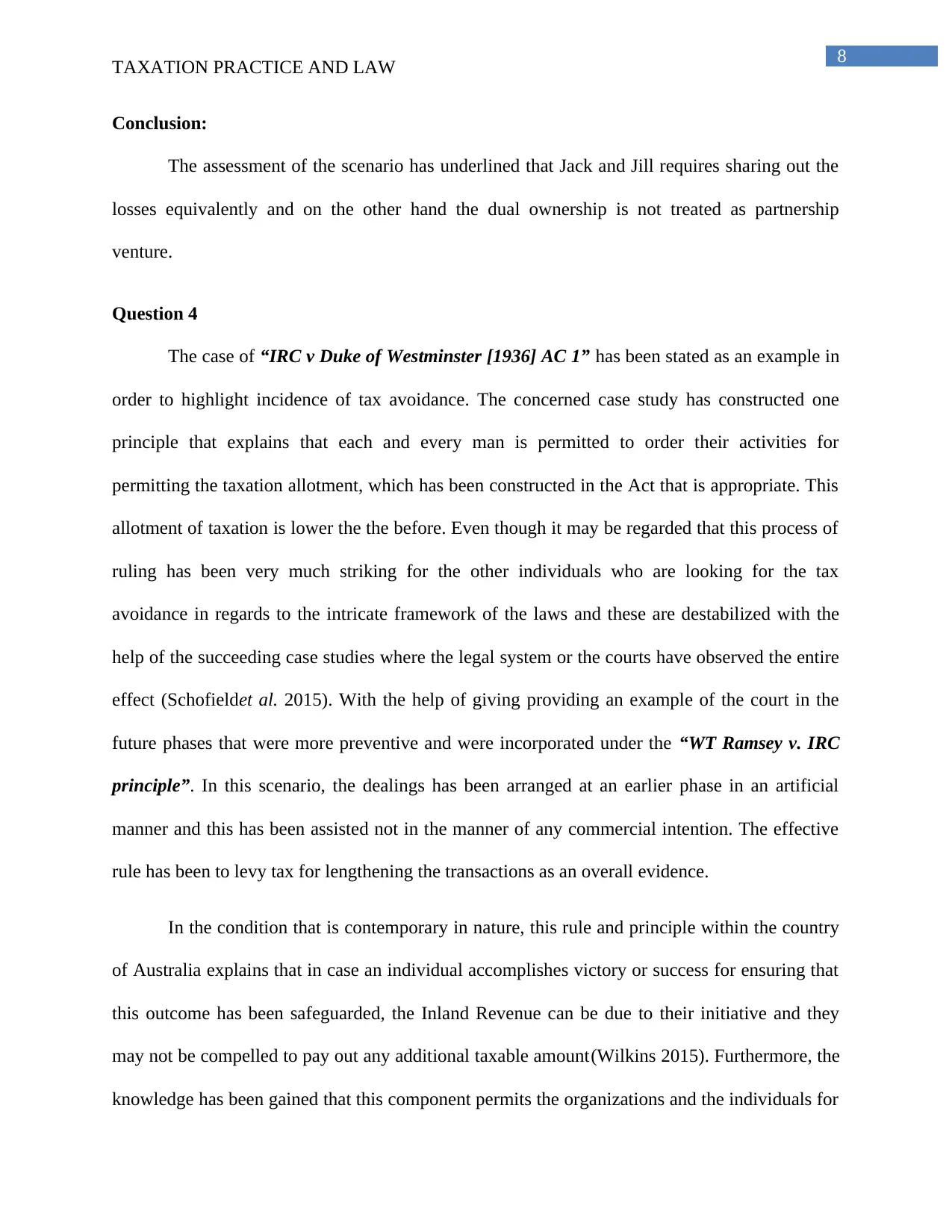
8
TAXATION PRACTICE AND LAW
Conclusion:
The assessment of the scenario has underlined that Jack and Jill requires sharing out the
losses equivalently and on the other hand the dual ownership is not treated as partnership
venture.
Question 4
The case of “IRC v Duke of Westminster [1936] AC 1” has been stated as an example in
order to highlight incidence of tax avoidance. The concerned case study has constructed one
principle that explains that each and every man is permitted to order their activities for
permitting the taxation allotment, which has been constructed in the Act that is appropriate. This
allotment of taxation is lower the the before. Even though it may be regarded that this process of
ruling has been very much striking for the other individuals who are looking for the tax
avoidance in regards to the intricate framework of the laws and these are destabilized with the
help of the succeeding case studies where the legal system or the courts have observed the entire
effect (Schofieldet al. 2015). With the help of giving providing an example of the court in the
future phases that were more preventive and were incorporated under the “WT Ramsey v. IRC
principle”. In this scenario, the dealings has been arranged at an earlier phase in an artificial
manner and this has been assisted not in the manner of any commercial intention. The effective
rule has been to levy tax for lengthening the transactions as an overall evidence.
In the condition that is contemporary in nature, this rule and principle within the country
of Australia explains that in case an individual accomplishes victory or success for ensuring that
this outcome has been safeguarded, the Inland Revenue can be due to their initiative and they
may not be compelled to pay out any additional taxable amount(Wilkins 2015). Furthermore, the
knowledge has been gained that this component permits the organizations and the individuals for
TAXATION PRACTICE AND LAW
Conclusion:
The assessment of the scenario has underlined that Jack and Jill requires sharing out the
losses equivalently and on the other hand the dual ownership is not treated as partnership
venture.
Question 4
The case of “IRC v Duke of Westminster [1936] AC 1” has been stated as an example in
order to highlight incidence of tax avoidance. The concerned case study has constructed one
principle that explains that each and every man is permitted to order their activities for
permitting the taxation allotment, which has been constructed in the Act that is appropriate. This
allotment of taxation is lower the the before. Even though it may be regarded that this process of
ruling has been very much striking for the other individuals who are looking for the tax
avoidance in regards to the intricate framework of the laws and these are destabilized with the
help of the succeeding case studies where the legal system or the courts have observed the entire
effect (Schofieldet al. 2015). With the help of giving providing an example of the court in the
future phases that were more preventive and were incorporated under the “WT Ramsey v. IRC
principle”. In this scenario, the dealings has been arranged at an earlier phase in an artificial
manner and this has been assisted not in the manner of any commercial intention. The effective
rule has been to levy tax for lengthening the transactions as an overall evidence.
In the condition that is contemporary in nature, this rule and principle within the country
of Australia explains that in case an individual accomplishes victory or success for ensuring that
this outcome has been safeguarded, the Inland Revenue can be due to their initiative and they
may not be compelled to pay out any additional taxable amount(Wilkins 2015). Furthermore, the
knowledge has been gained that this component permits the organizations and the individuals for
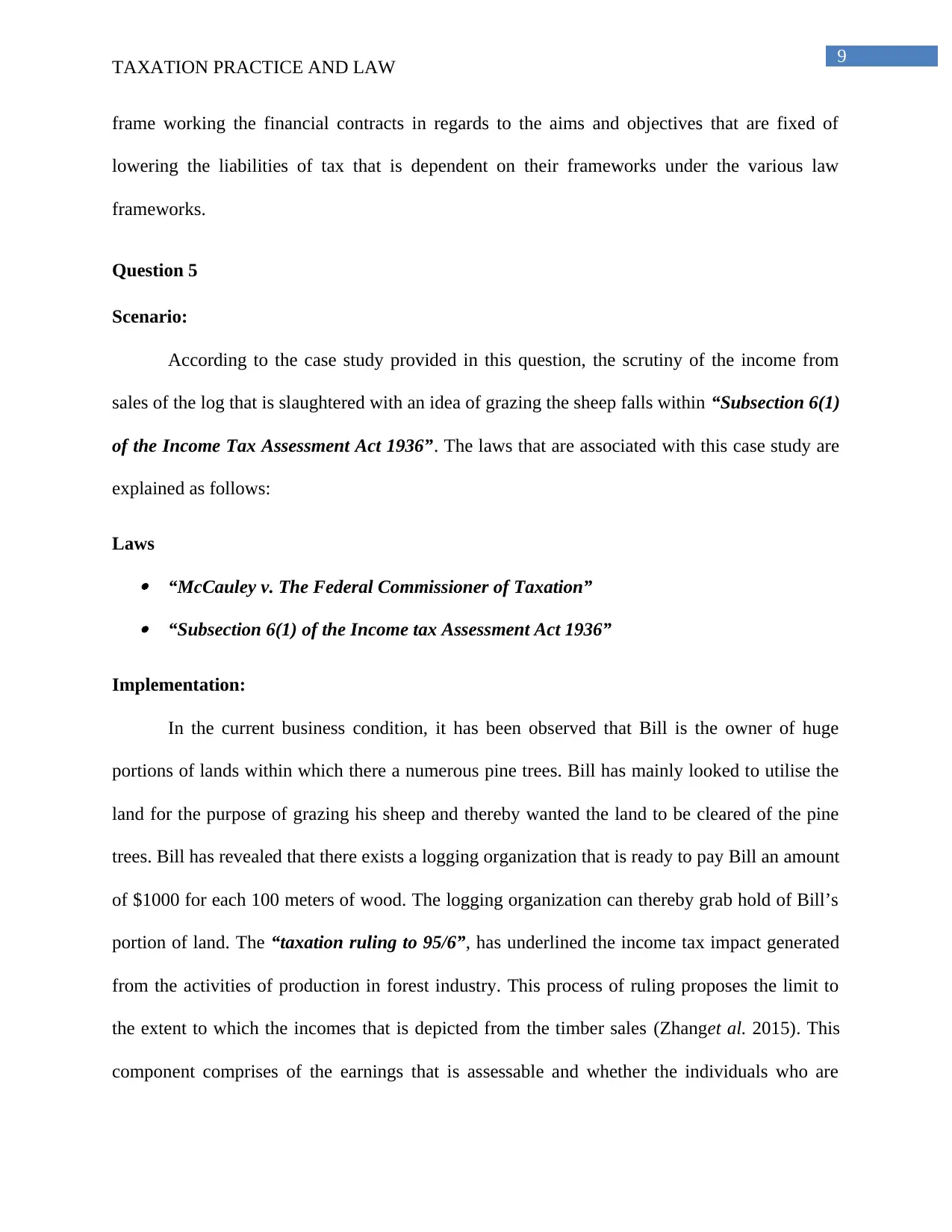
9
TAXATION PRACTICE AND LAW
frame working the financial contracts in regards to the aims and objectives that are fixed of
lowering the liabilities of tax that is dependent on their frameworks under the various law
frameworks.
Question 5
Scenario:
According to the case study provided in this question, the scrutiny of the income from
sales of the log that is slaughtered with an idea of grazing the sheep falls within “Subsection 6(1)
of the Income Tax Assessment Act 1936”. The laws that are associated with this case study are
explained as follows:
Laws “McCauley v. The Federal Commissioner of Taxation” “Subsection 6(1) of the Income tax Assessment Act 1936”
Implementation:
In the current business condition, it has been observed that Bill is the owner of huge
portions of lands within which there a numerous pine trees. Bill has mainly looked to utilise the
land for the purpose of grazing his sheep and thereby wanted the land to be cleared of the pine
trees. Bill has revealed that there exists a logging organization that is ready to pay Bill an amount
of $1000 for each 100 meters of wood. The logging organization can thereby grab hold of Bill’s
portion of land. The “taxation ruling to 95/6”, has underlined the income tax impact generated
from the activities of production in forest industry. This process of ruling proposes the limit to
the extent to which the incomes that is depicted from the timber sales (Zhanget al. 2015). This
component comprises of the earnings that is assessable and whether the individuals who are
TAXATION PRACTICE AND LAW
frame working the financial contracts in regards to the aims and objectives that are fixed of
lowering the liabilities of tax that is dependent on their frameworks under the various law
frameworks.
Question 5
Scenario:
According to the case study provided in this question, the scrutiny of the income from
sales of the log that is slaughtered with an idea of grazing the sheep falls within “Subsection 6(1)
of the Income Tax Assessment Act 1936”. The laws that are associated with this case study are
explained as follows:
Laws “McCauley v. The Federal Commissioner of Taxation” “Subsection 6(1) of the Income tax Assessment Act 1936”
Implementation:
In the current business condition, it has been observed that Bill is the owner of huge
portions of lands within which there a numerous pine trees. Bill has mainly looked to utilise the
land for the purpose of grazing his sheep and thereby wanted the land to be cleared of the pine
trees. Bill has revealed that there exists a logging organization that is ready to pay Bill an amount
of $1000 for each 100 meters of wood. The logging organization can thereby grab hold of Bill’s
portion of land. The “taxation ruling to 95/6”, has underlined the income tax impact generated
from the activities of production in forest industry. This process of ruling proposes the limit to
the extent to which the incomes that is depicted from the timber sales (Zhanget al. 2015). This
component comprises of the earnings that is assessable and whether the individuals who are
Secure Best Marks with AI Grader
Need help grading? Try our AI Grader for instant feedback on your assignments.
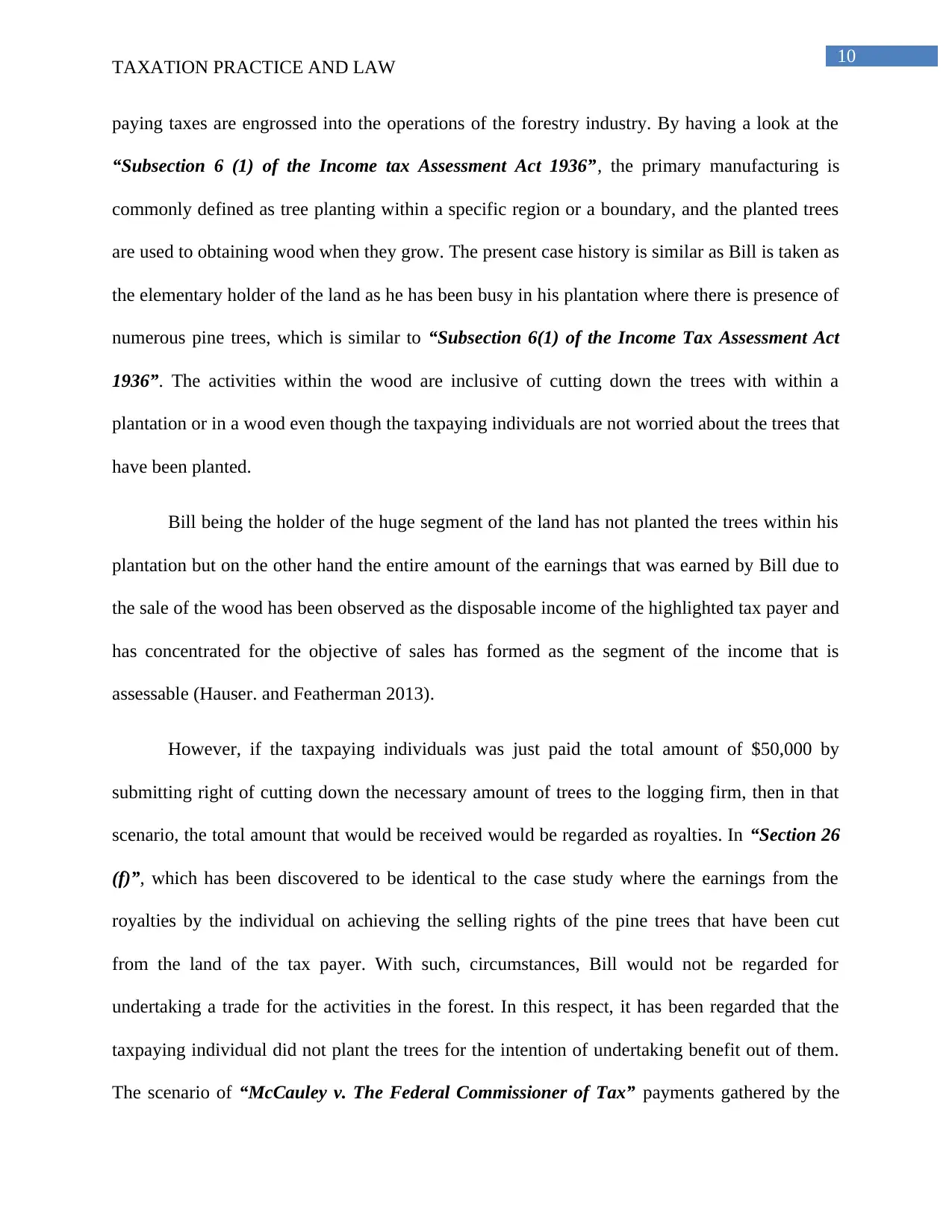
10
TAXATION PRACTICE AND LAW
paying taxes are engrossed into the operations of the forestry industry. By having a look at the
“Subsection 6 (1) of the Income tax Assessment Act 1936”, the primary manufacturing is
commonly defined as tree planting within a specific region or a boundary, and the planted trees
are used to obtaining wood when they grow. The present case history is similar as Bill is taken as
the elementary holder of the land as he has been busy in his plantation where there is presence of
numerous pine trees, which is similar to “Subsection 6(1) of the Income Tax Assessment Act
1936”. The activities within the wood are inclusive of cutting down the trees with within a
plantation or in a wood even though the taxpaying individuals are not worried about the trees that
have been planted.
Bill being the holder of the huge segment of the land has not planted the trees within his
plantation but on the other hand the entire amount of the earnings that was earned by Bill due to
the sale of the wood has been observed as the disposable income of the highlighted tax payer and
has concentrated for the objective of sales has formed as the segment of the income that is
assessable (Hauser. and Featherman 2013).
However, if the taxpaying individuals was just paid the total amount of $50,000 by
submitting right of cutting down the necessary amount of trees to the logging firm, then in that
scenario, the total amount that would be received would be regarded as royalties. In “Section 26
(f)”, which has been discovered to be identical to the case study where the earnings from the
royalties by the individual on achieving the selling rights of the pine trees that have been cut
from the land of the tax payer. With such, circumstances, Bill would not be regarded for
undertaking a trade for the activities in the forest. In this respect, it has been regarded that the
taxpaying individual did not plant the trees for the intention of undertaking benefit out of them.
The scenario of “McCauley v. The Federal Commissioner of Tax” payments gathered by the
TAXATION PRACTICE AND LAW
paying taxes are engrossed into the operations of the forestry industry. By having a look at the
“Subsection 6 (1) of the Income tax Assessment Act 1936”, the primary manufacturing is
commonly defined as tree planting within a specific region or a boundary, and the planted trees
are used to obtaining wood when they grow. The present case history is similar as Bill is taken as
the elementary holder of the land as he has been busy in his plantation where there is presence of
numerous pine trees, which is similar to “Subsection 6(1) of the Income Tax Assessment Act
1936”. The activities within the wood are inclusive of cutting down the trees with within a
plantation or in a wood even though the taxpaying individuals are not worried about the trees that
have been planted.
Bill being the holder of the huge segment of the land has not planted the trees within his
plantation but on the other hand the entire amount of the earnings that was earned by Bill due to
the sale of the wood has been observed as the disposable income of the highlighted tax payer and
has concentrated for the objective of sales has formed as the segment of the income that is
assessable (Hauser. and Featherman 2013).
However, if the taxpaying individuals was just paid the total amount of $50,000 by
submitting right of cutting down the necessary amount of trees to the logging firm, then in that
scenario, the total amount that would be received would be regarded as royalties. In “Section 26
(f)”, which has been discovered to be identical to the case study where the earnings from the
royalties by the individual on achieving the selling rights of the pine trees that have been cut
from the land of the tax payer. With such, circumstances, Bill would not be regarded for
undertaking a trade for the activities in the forest. In this respect, it has been regarded that the
taxpaying individual did not plant the trees for the intention of undertaking benefit out of them.
The scenario of “McCauley v. The Federal Commissioner of Tax” payments gathered by the
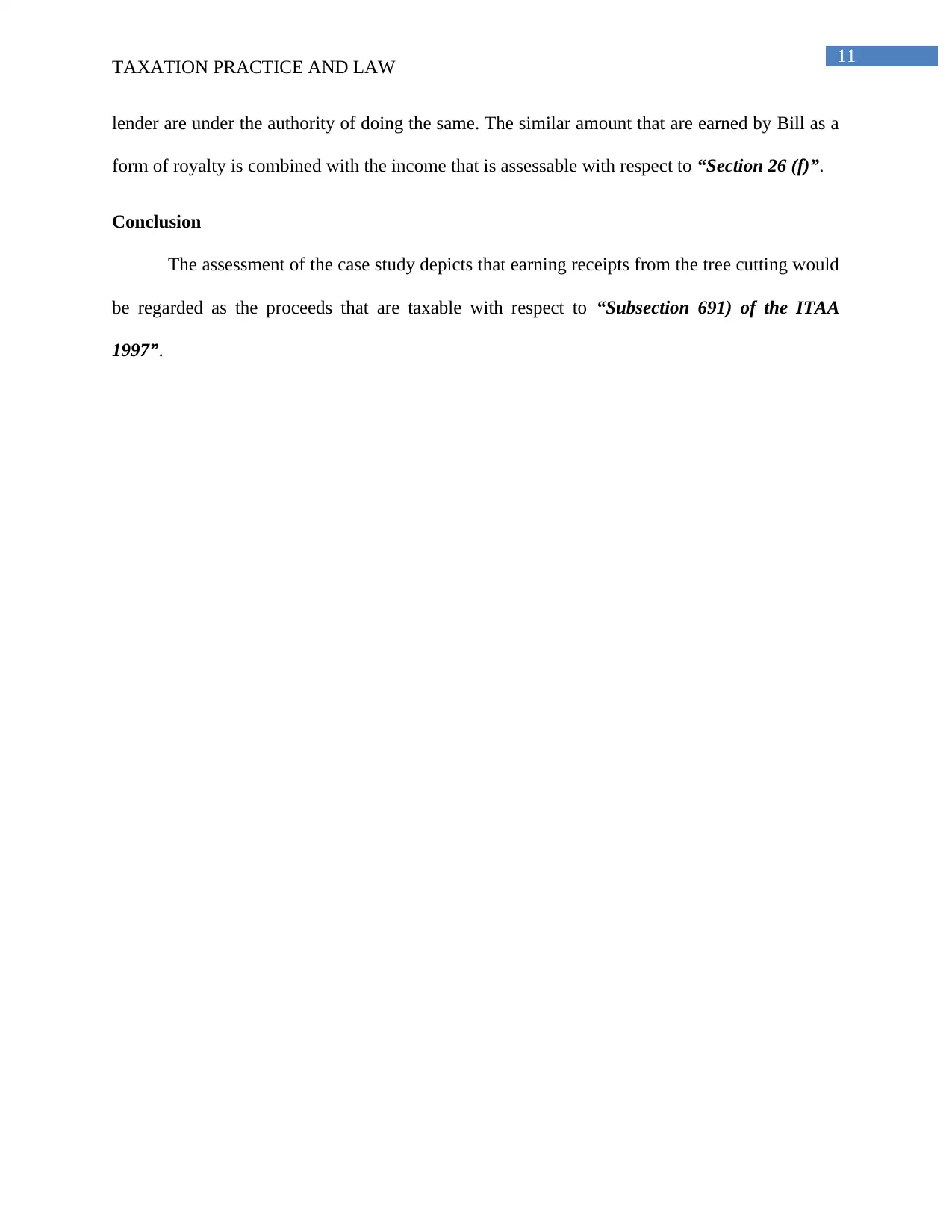
11
TAXATION PRACTICE AND LAW
lender are under the authority of doing the same. The similar amount that are earned by Bill as a
form of royalty is combined with the income that is assessable with respect to “Section 26 (f)”.
Conclusion
The assessment of the case study depicts that earning receipts from the tree cutting would
be regarded as the proceeds that are taxable with respect to “Subsection 691) of the ITAA
1997”.
TAXATION PRACTICE AND LAW
lender are under the authority of doing the same. The similar amount that are earned by Bill as a
form of royalty is combined with the income that is assessable with respect to “Section 26 (f)”.
Conclusion
The assessment of the case study depicts that earning receipts from the tree cutting would
be regarded as the proceeds that are taxable with respect to “Subsection 691) of the ITAA
1997”.
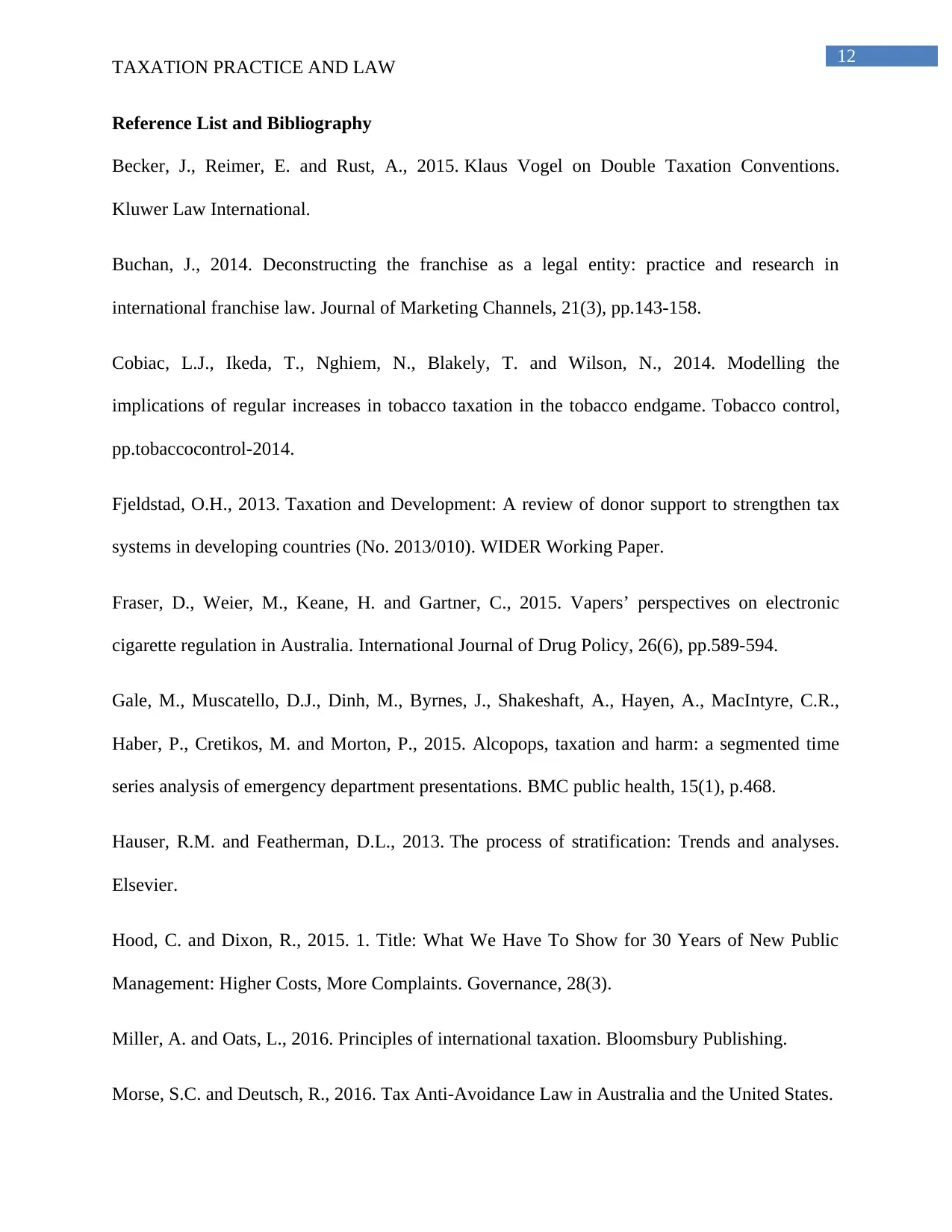
12
TAXATION PRACTICE AND LAW
Reference List and Bibliography
Becker, J., Reimer, E. and Rust, A., 2015. Klaus Vogel on Double Taxation Conventions.
Kluwer Law International.
Buchan, J., 2014. Deconstructing the franchise as a legal entity: practice and research in
international franchise law. Journal of Marketing Channels, 21(3), pp.143-158.
Cobiac, L.J., Ikeda, T., Nghiem, N., Blakely, T. and Wilson, N., 2014. Modelling the
implications of regular increases in tobacco taxation in the tobacco endgame. Tobacco control,
pp.tobaccocontrol-2014.
Fjeldstad, O.H., 2013. Taxation and Development: A review of donor support to strengthen tax
systems in developing countries (No. 2013/010). WIDER Working Paper.
Fraser, D., Weier, M., Keane, H. and Gartner, C., 2015. Vapers’ perspectives on electronic
cigarette regulation in Australia. International Journal of Drug Policy, 26(6), pp.589-594.
Gale, M., Muscatello, D.J., Dinh, M., Byrnes, J., Shakeshaft, A., Hayen, A., MacIntyre, C.R.,
Haber, P., Cretikos, M. and Morton, P., 2015. Alcopops, taxation and harm: a segmented time
series analysis of emergency department presentations. BMC public health, 15(1), p.468.
Hauser, R.M. and Featherman, D.L., 2013. The process of stratification: Trends and analyses.
Elsevier.
Hood, C. and Dixon, R., 2015. 1. Title: What We Have To Show for 30 Years of New Public
Management: Higher Costs, More Complaints. Governance, 28(3).
Miller, A. and Oats, L., 2016. Principles of international taxation. Bloomsbury Publishing.
Morse, S.C. and Deutsch, R., 2016. Tax Anti-Avoidance Law in Australia and the United States.
TAXATION PRACTICE AND LAW
Reference List and Bibliography
Becker, J., Reimer, E. and Rust, A., 2015. Klaus Vogel on Double Taxation Conventions.
Kluwer Law International.
Buchan, J., 2014. Deconstructing the franchise as a legal entity: practice and research in
international franchise law. Journal of Marketing Channels, 21(3), pp.143-158.
Cobiac, L.J., Ikeda, T., Nghiem, N., Blakely, T. and Wilson, N., 2014. Modelling the
implications of regular increases in tobacco taxation in the tobacco endgame. Tobacco control,
pp.tobaccocontrol-2014.
Fjeldstad, O.H., 2013. Taxation and Development: A review of donor support to strengthen tax
systems in developing countries (No. 2013/010). WIDER Working Paper.
Fraser, D., Weier, M., Keane, H. and Gartner, C., 2015. Vapers’ perspectives on electronic
cigarette regulation in Australia. International Journal of Drug Policy, 26(6), pp.589-594.
Gale, M., Muscatello, D.J., Dinh, M., Byrnes, J., Shakeshaft, A., Hayen, A., MacIntyre, C.R.,
Haber, P., Cretikos, M. and Morton, P., 2015. Alcopops, taxation and harm: a segmented time
series analysis of emergency department presentations. BMC public health, 15(1), p.468.
Hauser, R.M. and Featherman, D.L., 2013. The process of stratification: Trends and analyses.
Elsevier.
Hood, C. and Dixon, R., 2015. 1. Title: What We Have To Show for 30 Years of New Public
Management: Higher Costs, More Complaints. Governance, 28(3).
Miller, A. and Oats, L., 2016. Principles of international taxation. Bloomsbury Publishing.
Morse, S.C. and Deutsch, R., 2016. Tax Anti-Avoidance Law in Australia and the United States.
Paraphrase This Document
Need a fresh take? Get an instant paraphrase of this document with our AI Paraphraser
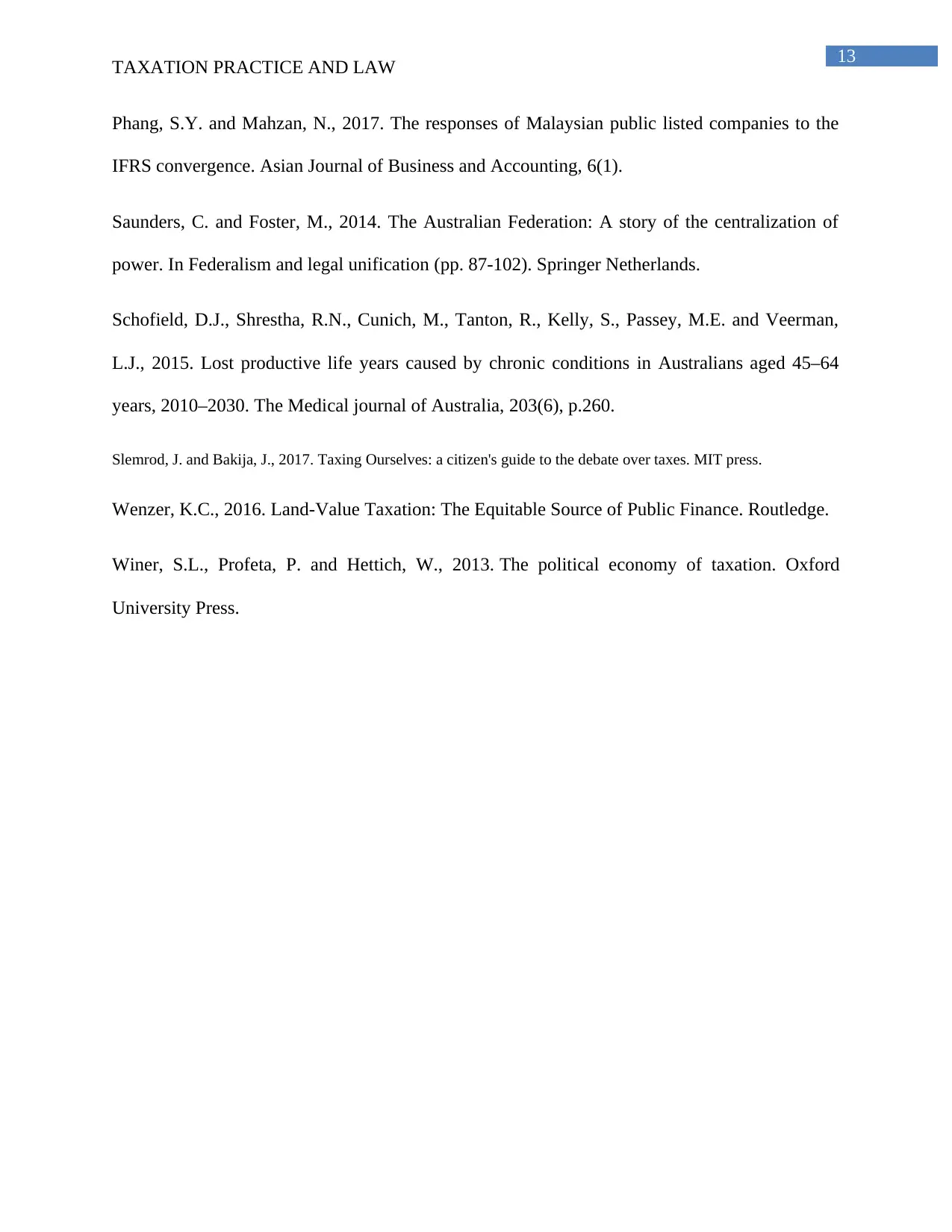
13
TAXATION PRACTICE AND LAW
Phang, S.Y. and Mahzan, N., 2017. The responses of Malaysian public listed companies to the
IFRS convergence. Asian Journal of Business and Accounting, 6(1).
Saunders, C. and Foster, M., 2014. The Australian Federation: A story of the centralization of
power. In Federalism and legal unification (pp. 87-102). Springer Netherlands.
Schofield, D.J., Shrestha, R.N., Cunich, M., Tanton, R., Kelly, S., Passey, M.E. and Veerman,
L.J., 2015. Lost productive life years caused by chronic conditions in Australians aged 45–64
years, 2010–2030. The Medical journal of Australia, 203(6), p.260.
Slemrod, J. and Bakija, J., 2017. Taxing Ourselves: a citizen's guide to the debate over taxes. MIT press.
Wenzer, K.C., 2016. Land-Value Taxation: The Equitable Source of Public Finance. Routledge.
Winer, S.L., Profeta, P. and Hettich, W., 2013. The political economy of taxation. Oxford
University Press.
TAXATION PRACTICE AND LAW
Phang, S.Y. and Mahzan, N., 2017. The responses of Malaysian public listed companies to the
IFRS convergence. Asian Journal of Business and Accounting, 6(1).
Saunders, C. and Foster, M., 2014. The Australian Federation: A story of the centralization of
power. In Federalism and legal unification (pp. 87-102). Springer Netherlands.
Schofield, D.J., Shrestha, R.N., Cunich, M., Tanton, R., Kelly, S., Passey, M.E. and Veerman,
L.J., 2015. Lost productive life years caused by chronic conditions in Australians aged 45–64
years, 2010–2030. The Medical journal of Australia, 203(6), p.260.
Slemrod, J. and Bakija, J., 2017. Taxing Ourselves: a citizen's guide to the debate over taxes. MIT press.
Wenzer, K.C., 2016. Land-Value Taxation: The Equitable Source of Public Finance. Routledge.
Winer, S.L., Profeta, P. and Hettich, W., 2013. The political economy of taxation. Oxford
University Press.
1 out of 14
Related Documents
Your All-in-One AI-Powered Toolkit for Academic Success.
+13062052269
info@desklib.com
Available 24*7 on WhatsApp / Email
![[object Object]](/_next/static/media/star-bottom.7253800d.svg)
Unlock your academic potential
© 2024 | Zucol Services PVT LTD | All rights reserved.





